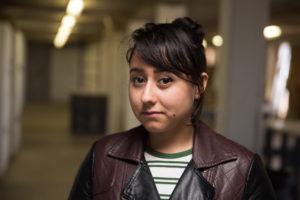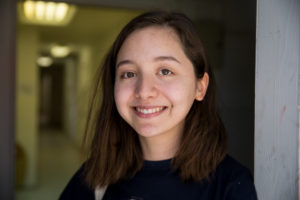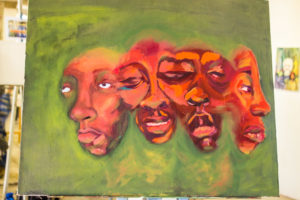Tags
Related Posts
Share This
Women Artists of Color
In these uncertain times, it can be difficult to focus on the student artwork made here at SFUAD. Our school fosters an incredible community of young artists expressing new ideas and educating each other through their art. The women artists of color on campus in particular bring an enriching perspective on the world, with projects ranging from body-positive visual art; new media art about the idea of identity in America; or spoken word poetry that examines sexuality and the body.
Elexsis Miller is a sophomore Studio Arts major who works a lot through her own identity as an African-American and confronting the questions that identity can bring. “I know where I was born, I know where I’ve moved to, where I’ve been. But where did I come from? Who are my ancestors? Who are those people? They can’t just be American,” Miller says. “From the way I’m feeling, we shouldn’t be here. We aren’t accepted here. So where do I come from?” Miller’s work was recently exhibited at Art.i.fact for the student show Color: An Exhibition Against Hate. Her painting shows a black face painted four times at different angles. “I talk about the acceptance of our bodies, African-American bodies. I talk a lot about the African-American and who we are.” Her current project for SFUAD’s Outdoor Vision Fest follows this theme of African-American acceptance but uses holograms instead of painting.

Garrett Johnston is a junior Digital Arts major. Photo by Jason Stilgebouer.
Digital Arts, one of the smaller departments at SFUAD, is home to junior Garrett Johnston, who is currently working on concept art for a project. “I’m doing a lot of concept design work right now because that’s what I want to do when I get into the industry. Right now I’m working on a project about a world that’s kind of based off early Americas and Native Americans and things like that except they’re little floating islands.” Johnston’s Native American heritage has been present in a lot of her art and one of her inspirations is her great grandmother. “[She] grew up on a reservation in Oklahoma and she made dolls and she has paintings in museums,” Johnston says. “She used to dress me up and we would go to powwows in Albuquerque, things like that. So I always come back to that point in my life.” Due to Johnston’s lighter skin, people often tell her she shouldn’t utilize aspects of the Native American experience in her art. “But I’m more than half Native American so it’s like, I kind of can if I want to.”

Lauryn Nesbitt is a Creative Writing student who performs slam poetry. Photo courtesy of Lauryn Nesbitt.
Creative Writing student Lauryn Nesbitt works primarily in words and performance through slam poetry. “I’ve always been writing whether it’s journals or little poems or songs or something. It’s always been kind of a release… And then I started slamming when I was in high school, which is my preferred genre.” With the support of her parents, Nesbitt attended art camps and performed in community theater when she was a child to expand her artistic realm. “Always being in a space of art allowed me to be multidimensional if I wanted to do a film or if I wanted to take pictures. For the most part I’m more [oratory.]” Her writing focuses on her personal experience—her grandmother, her spirituality, her hometown of Washington D.C., her body and her sexuality. “I definitely think I always represent a voice of an African-American woman in existence, just by default in how I respond to different things.”

Matilda Gutierrez makes paintings and illustrations. Photo by Jason Stilgebouer.
Matilda Gutierrez, a junior Studio Arts major, tackles the concept of identity in her art. Recently, in the student juried show Totally Unfair!, she had a series of paintings making fun of the stereotypes places on Millennials. She previously told Jackalope, “I was thinking about Millennials and how they were portrayed in the media and then I wanted take all of that and turn it into little humorous square paintings.” Her recent work concerns race and the place people of color hold in America. The new media piece, different from Gutierrez’ past paintings and illustrations, centers around eight t-shirts dyed in varying skin tones each with a word from the phrase “You don’t look like you’re from around here.” The shirts are in gradient from darkest to lightest, ending on the un-dyed white t-shirt with the word “here.”
The exploration of identity moves beyond Gutierrez’ art to her life and understanding of her own identity. “I want to work with more identity and like who does the term Hispanic apply to. Like I’ve never used it—I’ve used it in legal documents but I’m never like, ‘I’m Matilda, I’m Hispanic.’ I usually say, ‘I’m Matilda, I’m Mexican.’” Gutierrez struggles with the connotations placed on the word “Hispanic,” and how there is often a struggle associated with that identity that she has never experienced. “I’m aware because I grew up on the border but there’s a certain struggle attached to it and I don’t want to take credit for that by calling myself an artist of color.” Gutierrez uses her art to explore these aspects of herself, but ultimately her artistic identity is one in which she feels secure. “I don’t want to be a voice or anything. I just want to make stuff.”







 Jackalope Magazine is the student magazine of Santa Fe University of Art and Design. Building on the interdisciplinary nature of our education, we aim to showcase the talent of our university and character of our city.
Jackalope Magazine is the student magazine of Santa Fe University of Art and Design. Building on the interdisciplinary nature of our education, we aim to showcase the talent of our university and character of our city.
Recent Comments